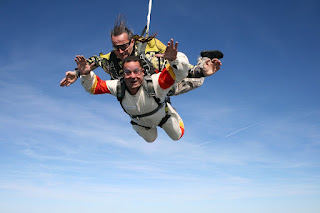The flight trajectory of a BASE jumper, who leaps from a fixed object such as a building, antenna, span, or Earth (hence the acronym BASE), can be explained by several principles of physics. When a BASE jumper jumps from a platform, their trajectory is influenced by forces such as gravity, air resistance, and their body position.
Gravity: Gravity is the primary force affecting the BASE jumper's flight trajectory. As soon as they leave the platform, gravity pulls them downward. This force accelerates their descent, causing them to fall towards the ground.
Air Resistance: Air resistance, also known as drag, opposes the motion of the BASE jumper. As they fall through the air, their body encounters resistance from the surrounding air molecules. The magnitude of air resistance depends on various factors such as the jumper's body position, the shape of their equipment (e.g., wingsuit or parachute), and their speed. By adjusting their body position and equipment, jumpers can alter the balance between gravity and air resistance, affecting their trajectory.
Body Position: BASE jumpers can manipulate their body position to control their trajectory. For example, a spread-eagle position increases surface area and air resistance, slowing down the descent and allowing for a longer glide. Alternatively, a streamlined position reduces air resistance, enabling faster vertical descent. In the case of wingsuit flying, the suit's fabric wings increase the surface area, generating lift and allowing the jumper to glide horizontally for a longer distance.
Parachute Deployment: In many BASE jumps, the jumper deploys a parachute to slow down their descent and ensure a safe landing. When the parachute is deployed, it creates significant air resistance, drastically reducing the jumper's speed and altering their trajectory. By skillfully controlling the parachute's steering lines, the jumper can navigate their descent and land at the desired location.
It's important to note that BASE jumping involves inherent risks, and understanding the physics involved is crucial for safety. BASE jumpers must have proper training, knowledge of their equipment, and experience in order to effectively manage their flight trajectory and ensure a controlled and safe descent.
Photo: Pixabay (free)

No comments:
Post a Comment
Thanks for your comment.